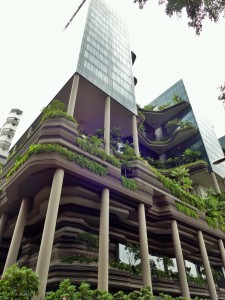By Renard Teipelke
After I visited the city-state Singapore in November 2014, I wanted to write a blog article about my impressions from extensively walking and experiencing the city. I am not residing there, but at least I took what others consider an extremely long ten days to learn about how the city developed over the past century (check out the Singapore City Gallery). Before I came to Singapore, I only heard very good or very bad comments, ranging from ‘sustainable urbanism par excellence’ to ‘non-democratic techno-regime’. Equipped with a strong practitioner’s interest and a critical geography background, I ended up being puzzled by how much Singapore got right. I could simply not believe in how far this city-state has actually realized/implemented all those recommendations on resource-efficient, equitable, sustainable, livable, creative, effective, smart, x-y-z (…) urban development. While concepts for good or ‘the best’ urban development are always debated, very often they aim at improving life in a particular city to some degree, i.e. technocratic ideals of hyper-smart cities will probably end up in an Orwellian state; however, a somewhat smarter city can improve quality of life for its residents and visitors in comparison to technology-poor cities.
 But instead of trying to formulate lessons learned from Singapore’s urban development, I rather provide you with a ‘take-away’ of the ten livable high-density urban development principles from a case study-, assessment-, and workshop-based research undertaken by the Urban Land Institute and the Centre for Liveable Cities in Singapore (see publication here). In addition to my ‘take-away’ summary, I will try to underscore what they have concluded through pictures that I have taken during my visit to this city-state.
But instead of trying to formulate lessons learned from Singapore’s urban development, I rather provide you with a ‘take-away’ of the ten livable high-density urban development principles from a case study-, assessment-, and workshop-based research undertaken by the Urban Land Institute and the Centre for Liveable Cities in Singapore (see publication here). In addition to my ‘take-away’ summary, I will try to underscore what they have concluded through pictures that I have taken during my visit to this city-state.
Principle 1: Plan for Long-Term Growth and Renewal
Take-away: Long-term planning is good, but it should be facilitating and guiding – not rigid and inflexible. Urban dynamics are an opportunity in strategic (shorter-term) planning.
 Principle 2: Embrace Diversity, Foster Inclusiveness
Principle 2: Embrace Diversity, Foster Inclusiveness
Take-away: Serious public housing makes a positive difference in dense cities. Interconnected private, semi-private, and public places are the design foundation of community life.

 Principle 3: Draw Nature Closer to People
Principle 3: Draw Nature Closer to People
Take-away: Nature is no separate part of the city. A network of urban greenery adds to place making, encourages outdoor activities, and preserves environmental quality.
 Principle 4: Develop Affordable Mixed-Use Neighborhoods
Principle 4: Develop Affordable Mixed-Use Neighborhoods
Take-away: Instead of mono-functional places, neighborhoods should combine live, work, and play. Walkability and mixed use are a good starting point to realize true communities.

 Principle 5: Make Public Spaces Work Harder
Principle 5: Make Public Spaces Work Harder
Take-away: Multi-tasking, flexible spaces with different use(r)s at different times of the day/week are the logical response to valuable urban land. No city can afford dormant spaces.
 Principle 6: Prioritize Green Transport and Building Options
Principle 6: Prioritize Green Transport and Building Options
Take-away: Governments have to nudge and incentivize people and businesses to move towards more eco-efficient practices, because they often come at a higher upfront cost.

 Principle 7: Relieve Density with Variety and Add Green Boundaries
Principle 7: Relieve Density with Variety and Add Green Boundaries
Take-away: Height gradation, design variations, density differentials – there are numerous ways to create neighborhoods with individual character and room to breathe.
 Principle 8: Activate Spaces for Greater Safety
Principle 8: Activate Spaces for Greater Safety
Take-away: Multi-purpose spaces are active, co-locations are lively, open design allows for visual access. A safe city is less about policing than about interlinkages of places and people.

 Principle 9: Promote Innovative and Nonconventional Solutions
Principle 9: Promote Innovative and Nonconventional Solutions
Take-away: Singapore and non-conventional do not go together!? How about a critical assessment of previous planning decisions and public-private-civil cooperation that promotes innovation.
 Principle 10: Forge 3P Partnerships
Principle 10: Forge 3P Partnerships
Take-away: Through a different style of communication and collaboration, “people, private, public” (3P) are fruitful seeds for new ideas, consensus-building, and broad-ownership solutions.

 The same as in every other city, plenty of challenges remain for Singapore. That makes it exciting. There is never an ideal, flawless urban development, so everyone is invited to contribute to better solutions. What I was very fascinated about is the commitment in Singapore to further improve livability for residents and visitors alike.
The same as in every other city, plenty of challenges remain for Singapore. That makes it exciting. There is never an ideal, flawless urban development, so everyone is invited to contribute to better solutions. What I was very fascinated about is the commitment in Singapore to further improve livability for residents and visitors alike.
———————————–
Source: Centre for Liveable Cities. 2013. 10 Principles for Liveable High-Density Cities: Lessons from Singapore. Singapore (Urban Land Institute & Centre for Liveable Cities). http://uli.org/wp-content/uploads/ULI-Documents/10PrinciplesSingapore.pdf


Pingback: IPM Bulletin archive – August 2015 – Institute of Place Management (IPM) Blog